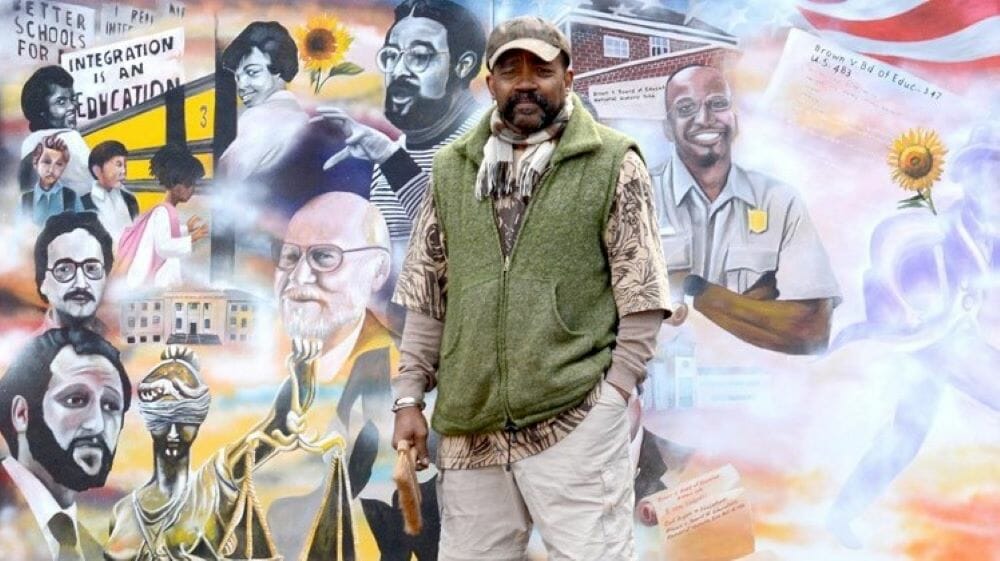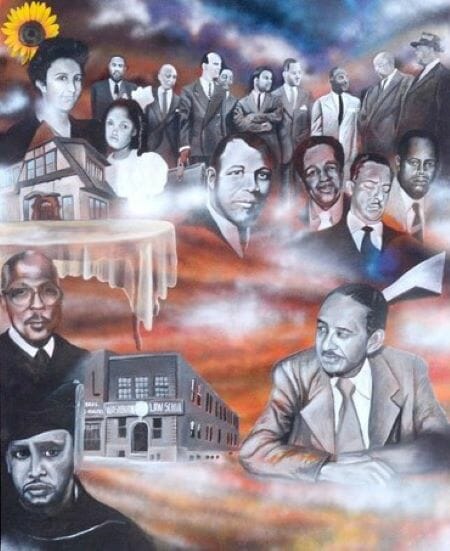KC Artist Marks Civil Rights Victory with Brown v. Board of Education Mural Artist Michael Toombs' 'Work of Love'
 Kansas City artist Michael Toombs with his mural commemorating the 1954 Brown v. Board of Education decision. The four-panel artwork is being installed in the entryway of the new Washburn University School of Law Building in Topeka, scheduled to open this summer. ((c) 2023 Janet Ryan)
Kansas City artist Michael Toombs with his mural commemorating the 1954 Brown v. Board of Education decision. The four-panel artwork is being installed in the entryway of the new Washburn University School of Law Building in Topeka, scheduled to open this summer. ((c) 2023 Janet Ryan)
Published July 21st, 2023 at 6:00 AM
Visitors to the new Washburn University School of Law Building in Topeka, scheduled to open this week, will be greeted by a mural commemorating one of the most important rulings in U.S. Supreme Court history.
The 1954 Brown v. Board of Education decision declared that racial segregation of children in public schools is unconstitutional. It would be an understatement to characterize the court’s action as groundbreaking; it was earth shaking. It permanently altered the landscape of U.S. race relations.
The mural, consisting of four panels that portray images evoking the court case and related historical elements, was created by Michael Toombs.
“I would consider it a work of love,” said Toombs, a well-known Kansas City-based public artist and art educator. “I worked around the clock.”
Toombs, a native Kansas Citian born in 1955, said it is “important that we make strides to enlighten our community about the importance of what this case has meant to our society.”

But Toombs cautioned that it’s just as important for people to realize that the societal advancements spurred by Brown v. Board are now under threat.
The Brown v. Board case took shape in Topeka when a group of Black parents, including Oliver Brown, tried to enroll their children in all-white schools. The U.S. District Court of Kansas ruled against the plaintiffs in 1951, after which the NAACP successfully appealed the ruling to the U.S. Supreme Court.
Patrick Mikesic, executive director of development and alumni relations for the Washburn University School of Law, said the new building that will house the mural will be dedicated July 21.
It is fitting that Washburn University will furnish a home for the new Brown v. Board mural. The school was named for Ichabod Washburn (1798-1868), an abolitionist and philanthropist who believed that all people had a right to an education.
Charles Scott, John Scott and Charles Bledsoe, three Black graduates of Washburn University School of Law, filed the Brown v. Board case in the U.S. District Court of Kansas Feb. 28, 1951.
“The thing I’m excited about with this mural is that it tells the story of Washburn University and its place in the history of the movement toward civil rights,” said Jeffrey Jackson, dean of the law school. “The mural here is going to inspire generations of Washburn Law students to go fight for what they believe in and know that they can make a difference in the world.”
Carla Pratt, dean of the Washburn University School of Law from 2018 to 2022, said the theme underlying the mural emerged during a capital campaign for the new building.
“Several African American alumni asked if we would be commemorating the Washburn alumni who championed racial justice in the Brown v. Board case,” said Pratt, who recruited Toombs to paint the mural.

The mural paintings include images conveying an 1850s Kansas Territory clash between pro-slavery and anti-slavery groups, signs carried by demonstrators in support of school integration, children boarding a school bus, and Lady Justice.
Individuals portrayed in the mural include Ichabod Washburn; Brown v. Board parent-plaintiff Lucinda Todd and her daughter, Nancy Todd; plaintiff attorneys John Scott and Charles Scott; NAACP attorney Thurgood Marshall (who later became a Supreme Court justice); and Sen. Bob Dole of Kansas and Congressman Jim Slattery of Kansas, who introduced legislation that created the Brown v. Board of Education National Historic Site (later renamed the Brown v. Board of Education National Historical Park).
The backgrounds of the panels evolve from storm clouds in the first panel to sunny skies in the fourth panel.
Toombs said the four segments of the mural, painted on thin veneer artist wood panels, will be displayed in the entryway of the new building.
The panels can be shared with other museums. “We’re hoping that the National Museum of African American History and Culture in Washington, D.C., might want to display this artwork at some point,” said Pratt, who currently serves as the Ada Lois Sipuel Fisher Chair in Civil Rights, Race and Justice in Law at the University of Oklahoma College of Law.
Ripple Effects
Although the Brown decision dealt only with public schools, it raised questions about segregation in other public facilities. The ripple effects opened new opportunities for youths such as Toombs, who grew up in a public housing project. When Toombs was in middle school he took a class with artist Matthew Monks at the Nelson-Atkins Museum of Art.
“Matthew didn’t see us as Blacks, he didn’t see us as troubled kids,” Toombs said. “He saw us as creative entities, and his responsibility was to nurture that in us. I think that experience, more than any other, became the foundation of my life and my questions, and what I work toward today.”
Toombs said the Brown ruling enabled him to attend the former West High School in Kansas City’s historic West Side neighborhood. The student population was primarily Hispanic
but included some Black and white kids.
“I think it was probably the best thing I ever did in terms of choices,” Toombs said. “It gave me a broader sense of society. It was very beneficial.”
Later in life Toombs took classes at the Kansas City Art Institute and completed a business entrepreneurship course through Donnelly College in Kansas City, Kansas. His wide-ranging career has included a stint in the insurance business and starting his own business, Storytellers Inc., Artist Collective.
“I’ve primarily been focused in the direction of social justice,” Toombs said. “I’ve done a lot of projects in that vein, mainly because I believe art is a tool that can be used to provide underserved communities opportunities to access information that they may not have been able to access any other way.”
Toombs’ Kansas City projects include a mural titled “Harmony on the Vine: Spill Paint Not Blood,” located in the atrium of the American Jazz Museum in the 18th and Vine District. The mural celebrates Kansas City’s jazz history.
Toombs spearheaded the creation of another Brown v. Board mural in 2018, when he led a team of nearly 30 artists in creating the “Brown v. Board Mural Project: Legacy & Vision.” This mural is located across the street from the former Monroe Elementary School in Topeka, which is part of the Brown v. Board of Education National Historical Park.
Toombs said his recently completed Brown v. Board mural for Washburn University “is probably one of the most significant individual accomplishments that I’ve done. With most of the paintings I do, I usually coordinate a large number of people and artists to facilitate. But this one I had to do myself.”
Sara Sonié Joi Thompson-Ruffin, a Kansas City-based contemporary fabric artist and a founding member of the African American Artists Collective, said Toombs is a brilliant artist who does extensive research. “That is the reason he is sought after in creating these types of murals as they pertain to the African American experience, the African American narrative, because he understands the power of the art and telling the story and sharing the experience.”
Thompson-Ruffin was born and raised in Joplin, Missouri, where her parents were involved in the civil rights movement. Her father, who served as vice president of the local NAACP branch, looked back on the Brown v. Board ruling as a life-changing event.
“My dad said he witnessed history that day, and he witnessed the protection of children,” she said. “They weren’t going to tolerate their children being mistreated. That wasn’t acceptable.”
Thompson-Ruffin characterized Brown v. Board as a “people’s movement” that “needed to happen.” And “art and any people’s movement go hand in hand,” she said.
Prints of the murals will be available to Washburn School of Law alumni and others “who want to share the story of the Washburn champions of justice that Michael Toombs so eloquently captured in artistic form,” Pratt said.
Meantime, Toombs said he is putting together a proposal to the city of Topeka for him to curate a 70th-anniversary celebration of Brown v. Board in 2024.
But he said it’s not enough to celebrate a battle won in 1954 and that America must guard against losing the gains that resulted from the historic court ruling.
“We’re in the process of dismantling compassion,” Toombs said. “This is manifesting in various ways throughout our society with all the shootings, fights on the planes, with our children in the schools. I believe the Brown case was a perfect example of what compassion contributes. It’s the thing that allowed us to live together, all these different cultures, all these different people from all these different nations. If we take that out of the equation, it’s going to get pretty ugly.”
Flatland contributor Julius A. Karash is a Kansas City-based writer. This article first appeared in KC Studio. It is part of an ongoing content collaboration between Flatland and KC Studio.




